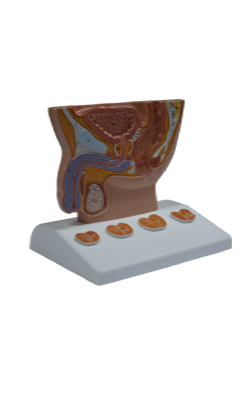Main Model

Internal sphincter muscle of anus

The anal canal is the terminal part of the large intestine and of the
entire digestive tract. It extends from the superior aspect of the
pelvic diaphragm to the anus. The canal (2.5-3.5 cm long) begins where
the rectal ampulla narrows at the level of the U-shaped sling formed by
the puborectalis muscle. The anal canal ends at the anus, the
external outlet of the alimentary tract. The anal canal, surrounded by
internal and external anal sphincters, descends postero-inferiorly
between the anococcygeal ligament and the perineal body. The canal is
collapsed, except during passage of feces. Both sphincters must relax
before defecation can occur.
The internal anal sphincter is an involuntary sphincter surrounding the superior two thirds of the anal canal. It is a thickening of the circular muscle layer. Its contraction (tonus) is stimulated and maintained by sympathetic fibers from the superior rectal (peri-arterial) and hypogastric plexuses. Its contraction is inhibited by parasympathetic fiber stimulation, both intrinsically in relation to peristalsis, and extrinsically by fibers conveyed by the pelvic splanchnic nerves. This sphincter is tonically contracted most of the time to prevent leakage of fluid or flatus; however, it relaxes (is inhibited) temporarily in response to distension of the rectal ampulla by feces or gas, requiring voluntary contraction of the puborectalis and external anal sphincter if defecation or flatulence is not to occur. The ampulla relaxes after initial distension (when peristalsis subsides) and tonus returns until the next peristalsis, or until a threshold level of distension occurs, at which point inhibition of the sphincter is continuous until distension is relieved.